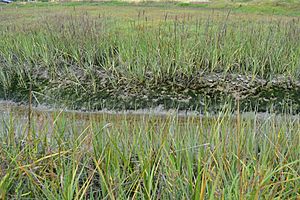California cordgrass facts for kids
Quick facts for kids California cordgrass |
|
|---|---|
 |
|
| Conservation status | |
| Scientific classification | |
| Synonyms | |
|
Sporobolus foliosus is a type of grass often called California cordgrass. It grows naturally in the salt marshes and mudflats along the coasts of California and Baja California. You can find it especially around San Francisco Bay. This plant is very important for its coastal habitat. Scientists reclassified it in 2014 from Spartina foliosa to its current name.
Contents
What is California Cordgrass?
California cordgrass is a plant that lives for many years. It grows from short underground stems called rhizomes. These rhizomes help the plant spread and stay rooted.
How it Looks
- Stems: It can grow as single stems or in thick clumps. The stems are fleshy and can reach up to 1.5 meters (about 5 feet) tall. They are usually green, but sometimes have a purple tint.
- Leaves: Its leaves are long and narrow. They can be flat or rolled inward.
- Flowers: The flowers grow in a tight, spike-like cluster. This cluster is called an inflorescence. It can be up to 25 centimeters (about 10 inches) long. Sometimes, the lower parts of the flower cluster are hidden by the plant's upper leaves.
Facing a Big Threat
California cordgrass is in serious danger. An invasive plant from the Atlantic coast is causing problems. This plant is called smooth cordgrass. It is not native to the Pacific coast.
The Invasion
Smooth cordgrass was brought to San Francisco Bay in the 1970s. It quickly started to hybridize with California cordgrass. This means the two species began to cross-breed.
Hybrid Problems
The new hybrid plants are very strong. They usually outcompete the native California cordgrass. These hybrids spread very fast. They threaten to cause localized extirpation of the native plant. This means the native plant could disappear from certain areas.
Both species reproduce at the same time of year. The invading smooth cordgrass releases a lot of pollen. This pollen fertilizes the flowers of the native plant. Because of this, most of the native plant's offspring become hybrids. This is an example of genetic pollution.
Hybrid Vigor
The new hybrid plants are much stronger than either parent plant. This is called hybrid vigor. It helps the hybrids spread even faster.
Protecting California Cordgrass
Even with these challenges, California cordgrass is still strong. It is the main plant in lower tidal areas of most salt marshes around San Francisco Bay. Many places in the Bay have not been affected by the invasive plant.
Efforts are ongoing to remove smooth cordgrass and its hybrids. People are working to bring back the natural tidal marsh habitat. This includes planting new California cordgrass. These plants are grown in nurseries from seeds collected in healthy areas.


